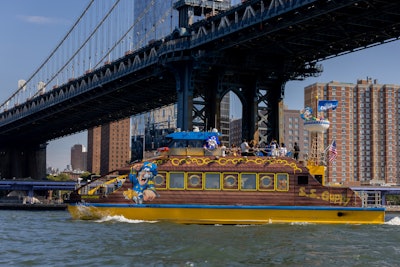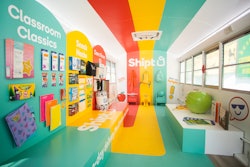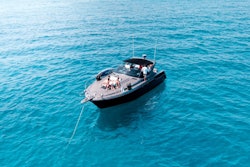
Does anything scream summer more than a day on a boat? Brands have been leaning into that idea this season, with companies like Cap'n Crunch and CBS recently hosting unconventional, vessel-based activations that offered a unique and memorable experience for guests. Read on to see inside these, plus other recent water-based activations—and keep scrolling to learn some top tips for hosting your own boat-based event.
Cereal brand Cap’n Crunch recently took to the seas—or, well, the rivers—surrounding New York City with a unique, branded ferry experience that took over a New York Water Taxi. Developed in response to the increasing number of people returning to the office, the “Cap’n’s Commute” livened up morning routines from Aug. 9-11 by making stops at five commuter ferry ports along the city's East River and Hudson River.
The ferry’s design was inspired by Cap’n Crunch’s S.S. Guppy—the ship the cereal star calls home—and was decked out with fun photo ops, a DJ, games, and, of course, plenty of Cap’n Crunch products. The brand worked with experiential agency Motive and fabrication company Pink Sparrow.
“Pink Sparrow was tasked with fabricating and installing a variety of scenic elements, including a cereal bowl crow's nest, barrels of Crunch Berries, a DJ booth, and a ‘Cap'n's Quarters’ complete with a ship’s wheel, anchor, sails, and props to capture the perfect Instagram-able photo,” explained Andrew McClain, Pink Sparrow’s fabrication director, who noted that his team relied heavily on 3D printing to get the intricate details they needed in a short timeframe.
“To reinforce the feel of a Cap’n Crunch ship, we did a complete refacing of the boat with branded blue and yellow features like portholes, netting, and fencing,” he added. “These elements helped to create an immersive experience that transported NYC commuters to their office in a cereal-filled paradise.”  The ferry featured a DJ, games, and a "Cap'n's Quarters" with a ship’s wheel, anchor, sails, and props for photo ops.Photo: Courtesy of Pink Sparrow
The ferry featured a DJ, games, and a "Cap'n's Quarters" with a ship’s wheel, anchor, sails, and props for photo ops.Photo: Courtesy of Pink Sparrow "Our favorite moment from the event was when the 'Cap'n Crows Nest' made its grand entrance," McClain said. "The reaction of both children and adults (and our fabrication team) was the same—complete awe. Hoisting an oversized cereal bowl flown atop a boat set sail was something we’d never done before!"Photo: Courtesy of Pink Sparrow
"Our favorite moment from the event was when the 'Cap'n Crows Nest' made its grand entrance," McClain said. "The reaction of both children and adults (and our fabrication team) was the same—complete awe. Hoisting an oversized cereal bowl flown atop a boat set sail was something we’d never done before!"Photo: Courtesy of Pink Sparrow
In another fun, floating activation, CBS continued its “Summer of Ghosts” campaign—a season-long event series celebrating different characters from the hit series Ghosts—with a Nordic-themed lunch at sea in LA’s Marina Del Rey neighborhood on Aug. 6. Designed to celebrate the show’s Viking warrior ghost, Thorfinn, the experience took place on board a yacht decked out with viking-inspired details and produced by creative agency BMF.
 "In honor of the character Thorfinn—a cod-loving Viking warrior—we wanted to pay tribute to the Viking spirit by inviting guests of CBS to experience a covetable and unique feast through a Viking lunch at sea," Jacobson said.Photo: Courtesy of BMF
"In honor of the character Thorfinn—a cod-loving Viking warrior—we wanted to pay tribute to the Viking spirit by inviting guests of CBS to experience a covetable and unique feast through a Viking lunch at sea," Jacobson said.Photo: Courtesy of BMF
Guests could also get personalized rune readings from an on-site intuitive practitioner and custom-engraved Viking-inspired wooden keychains.  “Once onboard, guests gathered around a transformed tablescape to connect over a bounty of rustic offerings of Norse-inspired flavors," she explained.Photo: Courtesy of BMF
“Once onboard, guests gathered around a transformed tablescape to connect over a bounty of rustic offerings of Norse-inspired flavors," she explained.Photo: Courtesy of BMF Guests could also pose with Viking props, receive personalized rune readings from an on-site intuitive practitioner, and get custom-engraved Viking-inspired wooden keychains.Photo: Courtesy of BMF
Guests could also pose with Viking props, receive personalized rune readings from an on-site intuitive practitioner, and get custom-engraved Viking-inspired wooden keychains.Photo: Courtesy of BMF
We asked McClain and Jacobson to share five tips for activating on a boat, yacht, or other vessel.
1. Understand the safety requirements from the very beginning.
Working on a moving ferry was a unique challenge, McClain said, noting that safety requirements meant the team had to be very careful—and creative—when it came to where equipment and props were placed and how they were secured.
“The biggest set of challenges with this project revolved around how active the boat is and how much the boat's operations are focused on passenger and crew safety,” he explained. “When combined, these create a pretty dense set of conditions that you don't encounter in the typical event venue or vehicle modification. Boats aren't like your typical white box space where there is flexibility with connection points, rigging, and securing fabricated elements.”
McClain’s advice? “Focus efforts on maximizing impact in areas of the vessel that wouldn’t interfere with the boat’s safety operations.”
Along the same lines, Jacobson added that understanding the vessel’s capacity is key. “Many vessels have strict capacity restrictions due to IMO (International Maritime Organization) guidelines, and these restrictions vary if the vessel is in port or at sea,” she noted.
2. Think through how guests will be able to move around the boat.
Another important consideration? The vast majority of furniture, seating areas, and storage units are all fixed in place and cannot be removed, which leads to limited space to activate, Jacobson explained.
“When designing your event, it’s important to first consider if the vessel will go to sea as part of the guest experience or be stationed in port,” she added. “If stationary, temporary build elements are much easier to bring in and install per normal on-land standards. If going to sea, considerations will need to be made to ensure any additional elements would remain safe in the event of encountering rough conditions.”
Thinking through the ways guests moved around the boat is also key from a fabrication standpoint, noted McClain. “If the event activity happening on the boat is different from its intended use, event design and layout should consider how the custom pieces are being interacted with,” he said. “Other than that, let your creativity flow when it comes to designing around these new interactions.”  The BMF team also produced BizBash’s own yacht-based activation, a partnership with Hubilo at Cannes Lions in June. "For any yacht activation, it is important to address any outdoor elements such as wind that may disrupt styling elements, or heat that requires shaded and cool-down moments," the team explained at the time, adding that it's also been important to think about constraints like whether guests will be required to remove their shoes. See more: Inside BizBash and Hubilo's Yacht Activation at Cannes LionsPhoto: Overflow Creative
The BMF team also produced BizBash’s own yacht-based activation, a partnership with Hubilo at Cannes Lions in June. "For any yacht activation, it is important to address any outdoor elements such as wind that may disrupt styling elements, or heat that requires shaded and cool-down moments," the team explained at the time, adding that it's also been important to think about constraints like whether guests will be required to remove their shoes. See more: Inside BizBash and Hubilo's Yacht Activation at Cannes LionsPhoto: Overflow Creative
3. Get creative with your exterior branding.
“Yachts can be huge in size—[and] while their exteriors provide a great blank space for branding, to make an impact you have to be intentional with placement while remaining cost-effective,” Jacobson said.
She added, “Vessels are painted using maritime-safe paint to help protect it from the salt, which often prohibits sticking anything to the exterior paintwork." A solution? “Focus on other existing branding opportunities, such as flags and—where applicable—sails.”
4. Give yourself extra lead time when possible—and do your homework.
McClain also advised preparing yourself for “the additional logistics and planning required—whether it’s the facility that can supply the vessel and the other resources needed to see through all of the production prep and build install, or just the different set of regulations around where and when the boat can be docked and for what purpose,” he said.
5. Make sure your catering team is fully prepped on the space available to them.
“Due to the nature of their normal on-board charter service, many yachts have impressive galley spaces to prepare food. However, refrigeration is often limited and reserved for the next charter and crew,” pointed out Jacobson. “Catering teams brought onboard need to work smartly and prepare ahead for extra provisioning, and pre-determine a style of catering service that can be managed in a smaller footprint.”  Want some more floating inspo to go? In September 2021, Resy and Amex teamed up to host Platinum Coast, a 225-foot-long, floating pop-up restaurant on New York's East River. Shiraz Creative outfitted the barge with contemporary design, lush greenery, a live DJ after dark, and a number of cabanas that seated up to six people.Photo: Teddy Wolff
Want some more floating inspo to go? In September 2021, Resy and Amex teamed up to host Platinum Coast, a 225-foot-long, floating pop-up restaurant on New York's East River. Shiraz Creative outfitted the barge with contemporary design, lush greenery, a live DJ after dark, and a number of cabanas that seated up to six people.Photo: Teddy Wolff In total, 20 different menus were served at Platinum Coast, with dishes inspired by the chefs' restaurants, hometowns, and more. See more: How Resy Brought Restaurant Events Back to Life During the PandemicPhoto: Sam Ortiz
In total, 20 different menus were served at Platinum Coast, with dishes inspired by the chefs' restaurants, hometowns, and more. See more: How Resy Brought Restaurant Events Back to Life During the PandemicPhoto: Sam Ortiz



















